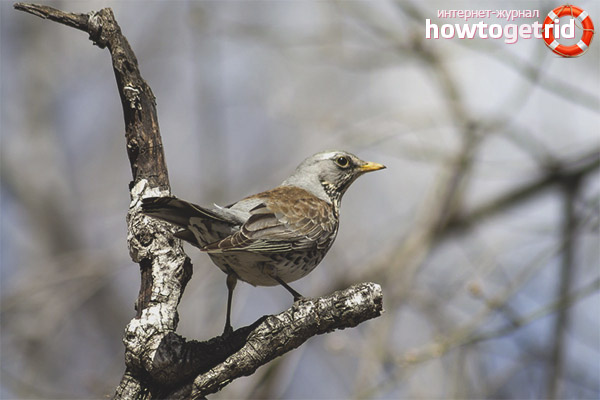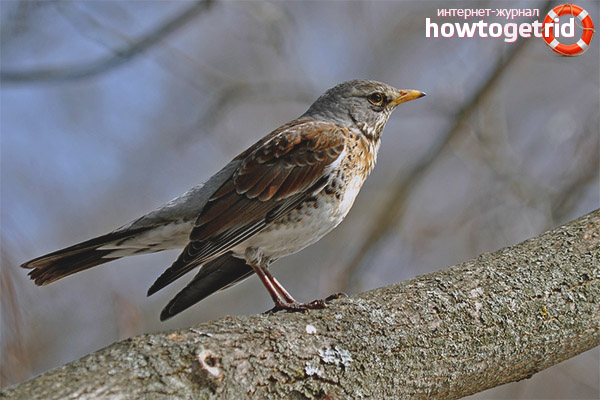The content of the article
The thrush family is very numerous. It includes more than a dozen species of birds. Fieldfare is one of the largest birds among all members of the family. Until recently, the field of horn could not be seen in the city or other settlement. Representatives of this species of birds lived only in the forest. Today, due to the fact that they cannot find enough food for themselves in their habitat, they can often be seen in the city. Birds seek food where there are trees with their favorite berries. These are parks, squares, and also mountain ash gardens.
There are a lot of these blackbirds in Russia. Most of them are in Siberia. In addition, the species is distributed almost throughout Europe.
The bird spends winter in the countries of Central Asia, the northern regions of Africa. Some individuals prefer to fly to the Caucasus.
Description
This bird, although not very bright in appearance, can hardly be confused with any other birds when looking at it. As already mentioned, among the blackbirds it is a rather large representative. The body in length reaches about 25 cm. And the wingspan in this case is about 50 cm or slightly less. The plumage in the area near the tail, partially on the head, as well as on the neck, has an ash-gray color.
In the back, the bird is covered with brown feathers. The plumage on the chest is white, has a slightly golden plaque and many small dark streaks. It is difficult to distinguish a male fieldfare from a female. After all, the color of the plumage is almost the same for them. In young individuals, the plumage has the same color as in adults. Their distinctive feature is that the coloring is somewhat paler than that of adult birds. It has been established that in nature, representatives of this species live on average from 10 to 16 years.
Lifestyle
They tolerate cold rather poorly. If in winter they cannot find food for themselves, then they fly away to warmer areas in order to safely winter. At the same time, quite a lot of birds die during migration. Abundance is influenced by weather conditions. If during the course of several years frosts are too severe in winter, the number of the species is reduced.
These birds are very similar to other representatives of the blackbird - white-browed. They are similar both in behavior and in the nature of their nutrition. Therefore, often representatives of these two species are combined into common flocks. Mountain ash is so named because the mountain ash berry is their favorite treat. They prefer to settle where you can eat plenty of it. They occupy a certain territory near the thickets, and protect it from other birds, who also would like to enjoy the mountain ash.
The behavior of these birds has one feature. When they attack an enemy, they usually begin to attack with their own droppings. For other birds that do not like the mountain ash, this poses a certain danger. After all, if the feathers of the bird will be smeared in the droppings, then they will stick together. As a result, the bird will lose its ability to fly. Quite often, people who find themselves in the wrong place are exposed to such attacks by fieldfields.
These birds tend to make a lot of noise. At the same time, they make unpleasant sounds. They have a crackling and bubbling voice. If a bird is frightened or angry for any reason, these sounds will be especially sharp and loud. Singing of this species of birds is also not very attractive. Yes, and you can hear it very rarely.
Fact! In moments of intense irritation and discontent, the bird raises its tail. On this basis, other birds immediately realize that the fieldfare is ready to attack.
This species is characterized by a grumpy character, so it is quite easy to provoke a fieldfare to provoke a fight and scandal. This has long been learned by birds of prey, which often use this feature. Often their nests become victims of a flock of ravens. Some of them distract the thrush to make him angry and provoke a fight, while others calmly take their eggs.
Power Features

The most diverse diet for fieldfare in the summer. They eat insects, worms, and arachnids. Sometimes they can also enjoy snails. And when various berries begin to ripen, the bird switches to them. Especially they like mountain ash.
They also like fruits, for example, apples and pears. The bird pecks fruits and berries, sitting directly on a branch or picks them up from the ground. These birds are real sweet tooth.
If a large number of mountain ash has ripened, the thrush will not fly south, but will spend the winter in nesting places. In winter, they feed not only on mountain ash. But also with wild rose, elderberry, viburnum.
In February, finding food becomes especially difficult. When all stocks of berries have already been eaten, the birds begin to feed on invertebrates found in water bodies. In the spring they feed on the field. When the land is plowed up, many larvae of various insects can be found in it.
Nesting
Before laying eggs, a pair of these blackbirds equips a nest. The female is directly involved in construction. And the male at this time zealously guards the future home. The constructed nest is similar in shape to a bowl. It is made of dried grass, which is connected together using clay and roots. The inner surface is lined with soft material. As a rule, the nest of this bird is located on a tree, in the place of a fork of powerful branches. They nest in small colonies, in which there are about 6-7 pairs. Sometimes colonies are more numerous.
Mating begins at the very beginning of May. In one clutch, birds have about 4-7 eggs. They have a camouflage color - greenish with small brown spots. Female hatching them. At the same time, the male does not even bring her food, so the bird has to be distracted from the hatching process for food.
Chicks appear in mid-May. They also fly away from their parents quite quickly - by the end of May. Both take care of the offspring.
Already in June, a pair of fieldfields begins the second clutch, in which, as a rule, a smaller number of eggs. Parents bring various berries to these chicks.
The benefits and harms of poultry
These birds, although they love forest berries, but if they come across a garden in which cultivated bushes and trees with sweet berries and fruits grow, then thrushes will peck them still immature.
Flocks of these birds often attack fields with strawberries, causing considerable damage to them. When there are no fruits in the garden, they eat in the forest. And when cherries, currants and apples ripen, they again fly into the garden.
But these birds also bring some benefits to mountain ash. Seeds that leave the bird undigested, then grow much better. This is due to the action of the gastric juice of the bird. Some gardeners know this and use it when growing mountain ash.
Video: Blackbird (Turdus pilaris)











Submit